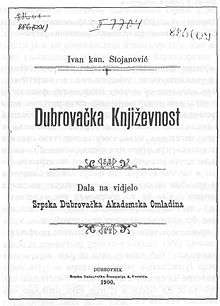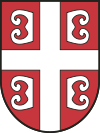Serb-Catholic movement in Dubrovnik
The Serb-Catholic movement in Dubrovnik (Serbo-Croatian: Dubrovački srbokatolički pokret) was a pan-Serb cultural and political campaign in Dubrovnik active at various periods between the 1830s and the interwar period. The group of local Catholic intellectuals, known as Serb-Catholics or Catholic Serbs, espoused a strong pro-Serbian sentiments. The most prominent incarnations of the movement were the early pan-Slavic phase under Matija Ban and Medo Pucić, and more Serbian nationalists, most active between the 1880s and 1908, led by a large number of Dubrovnik intellectuals at the time.
Background
Before the 19th century, the presence of Orthodox Serbs in the city of Ragusa/Dubrovnik was minute because the Republic of Ragusa enforced a single state religion of Roman Catholicism.[1] Orthodoxy was given equal status with Catholicism in 1848, by which time there were hundreds of Orthodox immigrants from Herzegovina in the city who maintained their religious affiliation with the Serbian Orthodox Church.[1] The Eparch of Dalmatia Josif Rajačić dispatched the first Orthodox priest to Dubrovnik, Đorđe Nikolajević, in 1833.[2]
History
The cultural and political movement of Serbs in Dubrovnik was started around this time, notably by Nikolajević's 1838 article in the newspaper Srbsko-Dalmatinski Magazin (published in Zadar by Božidar Petranović), where he claimed the entire Ragusan Slavonic literary corpus for Serbian literature.[3] In 1841, Medo Pucić, a writer from an old Catholic noble family, became acquainted with pan-Slavists Ján Kollár and Pavel Jozef Šafárik, and started to espouse a Serb national sentiment.[4] Matija Ban, another Catholic from Dubrovnik, was influenced by pan-Slavists and romantic nationalists Michał Czajkowski and František Zach in Istanbul, so much that he moved to Belgrade in 1844 in an attempt to promote his idea that Serbian patriotism must extend beyond Serbian Orthodoxy and the borders of the Principality of Serbia.[5] In Serbia, Ban's group of enthusiasts worked with Serbia's minister of the interior Ilija Garašanin, the author of Načertanije, to enter the upper reaches of Serbian political life.[5] They were not, however, met with uniform acceptance - Jovan Sterija Popović and others, with support of the Church in Serbia, protested against their ideas and by extension against Vuk Karadžić's notion that Serbian language and nationality extended beyond Orthodoxy.[6]
During the Revolutions of 1848 in the Habsburg areas (1848-1849), the Serbian government was involved on the side of the South Slavs in Serbian Vojvodina, and at the same time Matija Ban traveled to Croatian lands and advocated for pan-Slavic as well as pro-Serbian ideas, claiming the Kingdom of Dalmatia should be unified with the Kingdom of Croatia-Slavonia, but also describing the language of Dubrovnik as Serbian.[7] By 1850, the revolution was over and Ban, particularly because he had acquired Serbian citizenship in 1844, became suspicious to the Austrian police in Dubrovnik, who started to monitor him.[8] At that point, he was summoned to Belgrade where Garašanin suspended all of his operations and ordered him to permanently return to Belgrade.[9] He hesitated, but was persuaded by Prince Aleksandar and others to comply. He did however leave his family in Dubrovnik and published two more issues of the journal Dubrovnik in Ljudevit Gaj's publishing house in Zagreb in 1851 and 1852.[9]
Three decades later, in the 1880s a sizable group of Ragusan intellectuals independently developed a Serb-Catholic feeling, but at that point it was a political movement that was openly hostile to the Croats and whose leaders cooperated with the pro-Italian Autonomist Party (i.e. it was not pan-Slavic).[10]
Following the 1878 Congress of Berlin, the Habsburg Empire occupied Bosnia and created the Austro-Hungarian Condominium of Bosnia and Herzegovina, which prompted a confrontation between the Serb and Croat national ideologies, and the new "Serb-Catholic" circle of Dubrovnik increasingly broke with the pan-Slavic tradition of its founders, Pucić and Ban.[11] The same year, Serbia obtained independence.
In the preparation for the Imperial Council election of 1879, the Serb Party of Dalmatia severed ties with the People's Party, which marked a significant shift in Dalmatian politics at the time. Subsequently, in 1890, a coalition of the Autonomist Party and the Serb Party won the municipal election in Dubrovnik, where the Autonomists were considered to be "Serb-Catholics".[12] In the elections of 1899, local Croats saw their big mistake and a coalition of the People's Croatian Party (from 1899 new name of the People's Party in Dalmatia) and the Party of Rights came into power.

In 1904/1905, a cultural society "Croatian and Serbian People's Home" from Cavtat (south of Dubrovnik) promulgated pan-Slavic ideas.[13]
In 1908 (Austrian annexation of Bosnia and Herzegovina) all Serbian unions, clubs and newspapers in the city were closed and forbidden by Austrian authorities, which led to massive emigration of Serbian-oriented high society from the city of Dubrovnik.
Legacy
After World War I, in the Kingdom of Yugoslavia those Serbs who were left in Dubrovnik opted for the Yugoslav national unity, in contrast to Croats in the city who opted for the preserving of autonomous status of Croatia in Yugoslavia and unification of Dalmatia with Croatia-Slavonia. In 1939 Dubrovnik with its distruct became part of Banovina of Croatia which was established the same year. Those circumstances intensified emigration. During the Independent State of Croatia (1941-1945), the city completely reoriented itself to Croatian culture.
In recent times, the prominence of the 19th century Serb-Catholic movement in Dubrovnik was misused by proponents of the idea of Greater Serbia.[14]
Today, Serbs in Dubrovnik make up 2.73% of the town's population according to the 2011 census.[15]
Organisations
- Zadruga Srpkinja Dubrovkinja - founded in 1887
- Srpska dubrovačka akademska omladina (Serb Academic Youth of Dubrovnik) - founded in 1900
- Srpska Zora - founded in 1901
- Gimnastičko-sokolsko društvo Dušan Silni - founded in 1907 and headed by Mate Gracić
- Matica srpska - founded in 1909, thanks to Konstantin Vuković
- Pasarićeva štamparija
- Štamparija Mata Gracića
- Savez srpskih zemljoradničkih zadruga
- Srpska štedionica
Notable people
- Ivan Stojanović (1829–1900), Catholic clergyman.[16]
- Medo Pucić (1821–1882), Ragusan nobleman.[4]
- Matija Ban (1818–1903), writer.[17]
- Niko Pucić (1820–1883), politician and writer.
- Mato Vodopić (1816-1893), Catholic bishop.
- Francesco Ghetaldi-Gondola (1833–1899), Ragusan politician.
- Nikša Gradi (1825–1894), writer.
- Valtazar Bogišić (1834–1908), jurist and sociologist.[14]
- Lujo Vojnović (1864–1951), politician and writer.[14]
- Milan Rešetar (1860–1942), linguist.[14]
- Konstantin Vojnović (1832–1903), politician.
- Antun Fabris (1864–1904), writer.
- Pero Budmani (1835–1914), writer.[14]
- Luko Zore (1846–1906), philologist.
- Marko Car (1859–1953), writer.
- Stijepo Kobasica (1882–1944), writer.
- Marko Murat (1864–1944), painter.
See also
| Part of a series of articles on |
| Serbs |
|---|
 |
|
Native communities |
|
Related groups |
References
- 1 2 Banac 1983, p. 452
- ↑ Banac 1983, p. 453
- ↑ Banac 1983, p. 454.
- 1 2 Banac 1983, p. 455.
- 1 2 Banac 1983, p. 459.
- ↑ Banac 1983, pp. 459–460.
- ↑ Banac 1983, p. 461.
- ↑ Banac 1983, pp. 463–464.
- 1 2 Banac 1983, pp. 463-464.
- ↑ Banac 1983, pp. 464–465.
- ↑ Banac 1983, p. 473.
- ↑ Rajčić, Tihomir (October 2001). "Odnos Srpskog lista (glasa) prema autonomašima u Dalmaciji 80-ih godina XIX. stoljeća" [The Behaviour of the Serbian Party towards the Dalmatian Autonomists in Austrian Dalmatia]. Radovi / Institute for Historical Sciences of Croatian Academy of Sciences and Arts in Zadar (in Croatian). Croatian Academy of Sciences and Arts (43). ISSN 1330-0474. Retrieved 2011-09-01.
- ↑ Narodna zastava ujedinjenih Srba i Hrvata, Dubrovnik 1905 (in Serbian)
- 1 2 3 4 5 "'PITANJE BOŠKOVIĆA' Dr. Nikola Tolja: Posrbljenje Dubrovčana bio je čin otpora Beču i Pešti". Slobodna Dalmacija (in Croatian). 2012-02-07. Retrieved 2012-03-27.
- ↑ "Population by Ethnicity, by Towns/Municipalities, 2011 Census: County of Dubrovnik-Neretva". Census of Population, Households and Dwellings 2011. Zagreb: Croatian Bureau of Statistics. December 2012.
- ↑ Banac 1983, p. 449.
- ↑ Banac 1983, p. 456.
Sources
- Banac, Ivo (1983). "The Confessional "Rule" and the Dubrovnik Exception: The Origins of the "Serb-Catholic" Circle in Nineteenth-Century Dalmatia". Slavic Review. 42 (3): 448–474. JSTOR 2496046. (Registration required (help)).
- Borak, Svetozar (1998). Срби католици (PDF). Novi Sad: СД „Др Јован Рашковић.
External links
- Mitrović, Jeremija D. (1992). Srpstvo Dubrovnika (in Serbian). Belgrade: Srpska književna zadruga / Project Rastko. ISBN 9788637903192.